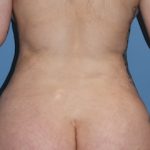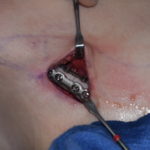 Lumpectomies for the treatment of breast cancer is an increasing method of therapy that spares much of the breast. With earlier detection of breast cancer today, less invasive and better breast conservation is now commonplace. Lumpectomies, however, leave indentations and crater-like dents after the cancerous tissue has been removed. Because of the size and location of lumpectomy defects, the traditional use of breast implants for reconstruction may not always result in a satisfactory solution. Other autologous methods of breast reconstruction such as muscle and skin-fat flaps may be too big of an operation for the problem with donor scars that are undesired. Recent work around the world has led to a new and less invasive method of breast reconstruction for lumpectomy defects. Provided adequate breast skin is present, filling the space where the breast tissue was removed can restore areas of indentations and collapse. Using cosmetic liposuction techniques, fat cells are harvested , stem cells extracted from the fat, and a combination of stem cells and purified fat is injected into the breast defect. Lumpectomies for the treatment of breast cancer is an increasing method of therapy that spares much of the breast. With earlier detection of breast cancer today, less invasive and better breast conservation is now commonplace. Lumpectomies, however, leave indentations and crater-like dents after the cancerous tissue has been removed. Because of the size and location of lumpectomy defects, the traditional use of breast implants for reconstruction may not always result in a satisfactory solution. Other autologous methods of breast reconstruction such as muscle and skin-fat flaps may be too big of an operation for the problem with donor scars that are undesired. Recent work around the world has led to a new and less invasive method of breast reconstruction for lumpectomy defects. Provided adequate breast skin is present, filling the space where the breast tissue was removed can restore areas of indentations and collapse. Using cosmetic liposuction techniques, fat cells are harvested , stem cells extracted from the fat, and a combination of stem cells and purified fat is injected into the breast defect.
This innovative, but not completely proven, treatment is based on the awareness that subcutaneous fat is a rich source of stem cells. Stems cells are pluripotent cells that can be theoretically stimulated to turn into new fat cells. (perhaps this is what happens from crash dieting and then rebound weight gain?) Fat is suctioned, usually from the abdomen or hips, and the stem cells are then isolated through a centrifugation method. The extracted stem cells are then mixed in with the remaining fat and injected it into the breast lumpectomy defect.site. The hope is that the use of stem cells will help keep the transplanted fat alive…or become fat cells themselves. Either way, the volume of injected material remains because it becomes living tissue. The American Society of Plastic Surgery has issued a specific position paper on the use of injected fat into the breast. In summary, they state the its use and the final results are affected by a lot of different factors, particularly the technique used to harvest, concentrate, mix, and ultimately inject into the breast. The procedure is highly operator dependent. It use in the breast is lacking sufficient scientific studies to determine long-term effectiveness. The decision to use fat injections in the breast is one to be decided between patient and their plastic surgeon. The use of fat injections, with or without stem cells, has a lot of use and recent history for facial and buttock augmentation. In my Indianapolis plastic surgery practice, my experience with stem cell concentrates is limited but I have often used platelet-rich plasma (PRP) with fat to enhance survival. The combination of cleaned and purified fat, stem cells, and PRP would be the ultimate therapeutic cocktail. This may be a bit of an alchemist’s approach, but all the components are autologous and would cause no harm. The goal is how to optimize fat graft survival and maintain volume. I am confident that both PRP and stem cell additions are useful but the question is which one of the two is better. At present, this is unknown. |
Dr. Barry Eppley
Indianapolis, Indiana


